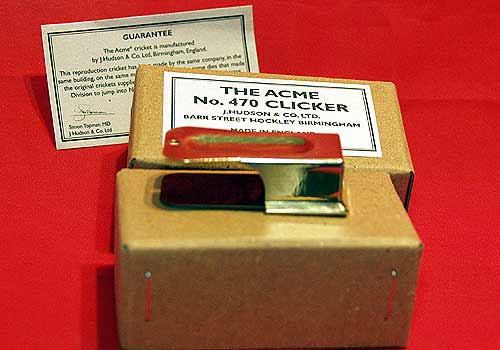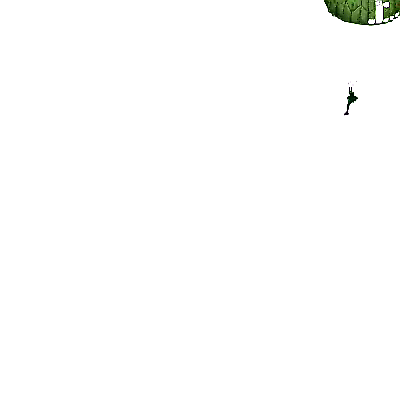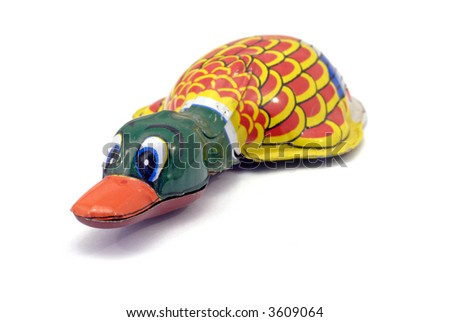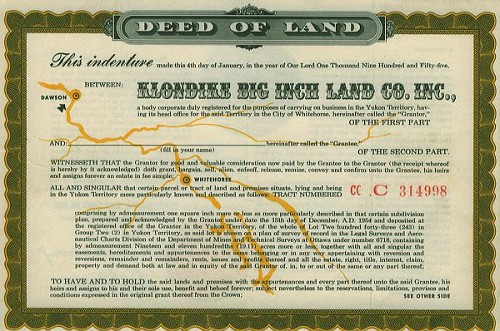TAMPA, Fla. (June 3) - Capt. Sam Gibbons knew his mission was in trouble when he hit the ground in the early hours of the D-Day invasion 63 years ago. The future congressman's 101st Airborne troops were scattered far from their intended drop zone. And the only nearby soldiers he could see where German.
"People are always talking about behind enemy lines. Hell, there ain't no lines in combat," said Gibbons, who was 24 when he parachuted into Normandy on June 6, 1944. "We jumped right on top of the Germans."
On the ground, in the dark, the scattered American soldiers relied on a children's' novelty toy to sort things out.
Gibbons, now 87 and retired after serving 17 consecutive terms in Congress , is one of the few Operation Overlord paratroopers who held onto his military-issued "cricket," a brass and steel version of the cheap tin prize from a 1930s Cracker Jack box. The soldiers called the signaling devices "crickets" because of the sharp "crick" sound it made when pressed.
The crickets were lifesavers for American paratroopers scattered in the dark on a morning when using a flashlight to check a map or shouting in English meant instant death.
"The cricket was a stroke of genius," said Michael Gannon, a retired University of Florida history professor. "How else would you know who you bumped into in the dark? If you came across somebody, you clicked. If he responded in kind, you were friends. If he didn't, you shot him."
Gibbons landed in a pasture at 1:26 a.m. A group of Germans less than a football field away were firing furiously at the sky full of planes and parachutes and didn't see him. It took him half an hour to crawl out of the pasture.
U.S. Chutists' Kit Amazes Germans
U.S. Chutists' Kit Amazes Germans An article on page 4 of the U.K.Edition of The Stars and Stripes newspaper of Tuesday, June 27, 1944, carried the above-captioned headline.
Part of the text of the article reads:
"American paratroopers' equipment was described in a German broadcast yesterday as "luxury" kit.
"No other unit in the world is so well equipped as the American paratroops", said Gunther Weber, German Overseas News Agency correspondent. Staff officers at Marshall Rundstedt's own headquarters describe them as 'luxury divisions'.
Weber marveled at a tiny compass, steel files, first-aid equipment, aerial photographs, maps drawn on silk, morphine pills, chewing gum, and instruments for the imitation of animal sounds at night."
He said that on several occasions, paratroops 'landed right on top of German high command posts in Normandy', forcing German generals and staff officers to engage in hand to hand fighting."
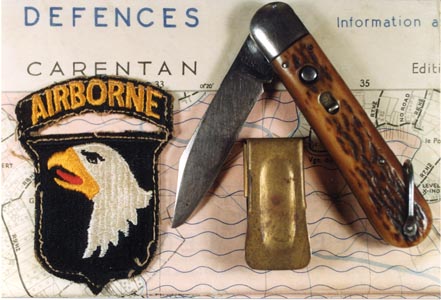
A few gadgets used by 101st paratroopers on the Normandy invasion jump: in the rear, a detailed map of the Carentan France area, showing Drop Zone 'D'-this was issued to Fred Baynes of 2/501 in a white cloth bag with British markings on the bag. The M-2 switchblade knife was carried in the upper chest, dual-zippered knife pocket of the M42 jump jacket. This example features brown, picked bone handles and was made by the George Schrade Co. in Bridgeport, CT. It is marked 'PRESTO' on the ricasso of the blade. This one was carried by Albert A. Krochka of H&H S-2, 501 PIR. The Type 7 U.S. made 101st eagle patch was worn by Sgt Bill Knight of C/506th. The brass cricket signalling device belonged to Eugene Beach, of 2/501 LMG.
D-Day CRICKET Lore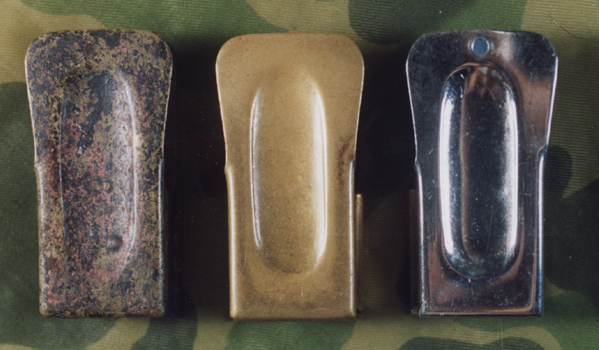
I thought the TT crowd might enjoy seeing this photo of 3 genuine crickets. At left is one of the hoard purchased by Sparky Patterson from a young man who grew-up in Normandy. This guy's father was employed by the American Battle Monuments Commission and he spent countless childhood hours metal detecting and digging in France. This example has been in a fire and was probably salvaged from the trash pit at the 'Ghost Ridge', near the Colleville-St Laurent cemetery.
The center example is a typical veteran bring-back, in this case acquired from I/502 veteran Chester Elliot.
The example at right was acquired recently from the son of Captain George Lage, 2nd battalion sugeon of the 502 PIR. It is one of the examples made by the ACME Thunderer Whistle Co. in England, nickel-plated and maker-marked. These had been produced for the commercial toy market, prior to the spring of 1944. When American QM personnel asked ACME to manufacture 7,000 more in a hurry, that company sold all the nickel-plated and maker-marked examples they had in stock, then went into speed production and made the balance of the required number out of plain brass, and without any markings. When crickets were issued to 101st Airborne personnel for use on D-day, the maker-marked examples were mixed-in with the more numerous brass ones and there seems to be no pattern, as to who received the ACME- marked examples.
In my personal observations, the plain brass crickets have outnumbered the marked examples by at least 10 to 1.
I know that Gene Madison of HQ/501 was issued a marked cricket, as well as Frank Hoffman of E/502. Both those guys were enlisted personnel. Now we also know that Doc Lage in HQ/2 502 PIR received one as well. I know Mike Detrez has a couple marked crickets with vet provenance in his collection but I don't know who they came from or which sub-units they are attributed to.
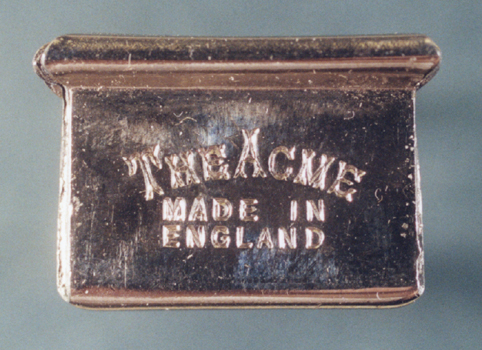
This photo shows the end markings on the nickel-plated Lage cricket-note that the markings are upside down on the cricket. Charles Day wrote to the ACME company recently and they stated that the maker markings were 'stamped' into the plated crickets and that nickel was the substance used for the plating.
Aside from the fact that Lage's plated cricket is in unbelievably pristine condition (nickel does not tarnish much), you can also see that a hole was professionally aligned, centered and drilled, unlike the crude holes usually seen on brass crickets. Some of those were bored with a M2 knife point or punched with a hammer and nail.
I brought Captain Lage's dogtags and cricket along on the May 07 Normandy tour and showed them at the Doc's D-day aid station, at Holdy. The tour group members could not believe that such a pristine-looking piece of equipment was actually used in the Invasion of Normandy, sixty-three years ago.
Inevitably, some of the ACME-marked specimens which were sold into the toy market before June, 1944, are in circulation and aside from direct veteran provenance, there is no way to tell them apart from Doc Lage's. Sparky found an Internet seller in Texas recently, who had a small batch of nickel-plated, marked ACME crickets for sale. Although identical to the one illustrated above, that batch had no connection to ever being used by paratroopers.
Mr deTrez also has a marked example made of plain tin, or some other ferrous metal, which has 2nd-hand vet provenance. Evidently some unfinished examples were also procured by QM personnel in the pre D-day rush.
Four Original D-Day Crickets
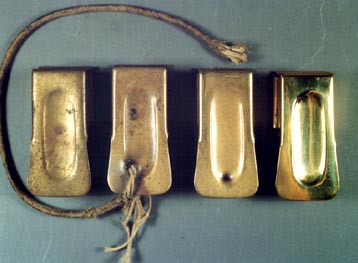
A top view of four other original crickets from the webmaster's collection. Specimen at left was used by Eugene Beach of 2/501 LMG platoon. Specimen 2d from left is from Sgt Bill Knight C/506th, who landed at Ravenoville. Part of the cord with which Bill hung it around his neck for D-Day is still present. The rather large, crude hole in the top was made with a M2 jump knife. The specimen 2d from right belonged to radioman T-5 Dick Rowles of E/501-It has a rather neat and centered nail hole punched through the top. The specimen at far right was carried by C.C. Moore of F/501, and was polished, in order to discover what it would have looked like when issued.
Two Deuce Vets with their Crickets
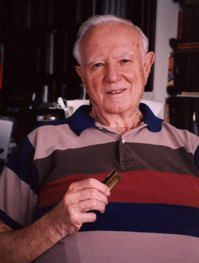
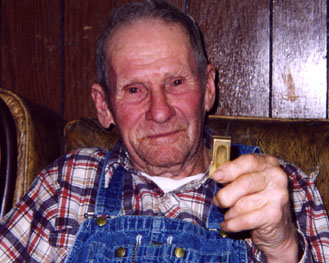
Captain Joe Pangerl of IPW Team #1, 502 PIR (l) and Pfc Chester Elliott of I/502, display the plain brass crickets they were issued for D-day.
Note that both vets grasp their cricket with their index finger merely stabilizing the brass portion of the device, while their thumb presses the spring steel snapping plate. This is the most efficient way to elicit the sharp, desired 'click-clack' sound from the cricket.
Both of these crickets are in the webmaster's collection.
BRITISH LEG BAG
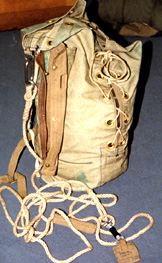
On the Normandy jump, many individuals stashed all their spare equipment and even their weapons in a British made leg bag as shown above. The bag could be lowered on a 15 foot rope to dangle below the jumper after his parachute opened, so he would be free of the weight of it when landing. However, the vast majority of men who jumped with leg bags in Normandy had them torn-off by the opening shock of their deploying parachutes. The bags and contents sailed off into pitch black Norman air space never to be seen by the original owners again. American Rigger M/Sgt Joe Lanci developed an improved version of the leg bag in time for the Holland jump in September, 1944. photo c/o Dennis Davies.
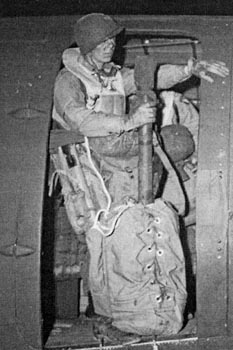
This daredevil, Dick Knudsen of F/506th jumped into France with a Brit-made leg bag containing his bazooka rocket launcher. When his chute opened, he didn't have time to release the bag before hitting the ground. Upon landing several hundred yards from St Mere Eglise, he broke his pelvis. Knudsen laid unaided in no man's land for several days before being discovered and evacuated. photo c/o Charles Young 439th TCG
Equipment Bundle Light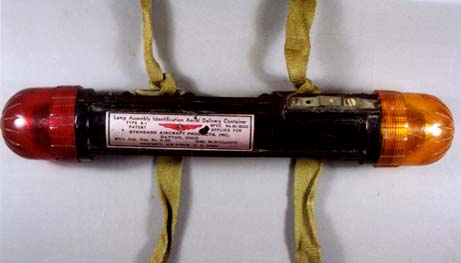 Lights, like the gadget pictured above, were attached to equipment bundles to aid in locating them at night. This specimen comes from Sgt Ed Benecke of A/377th PFA Bn., and note the 3/4" web tape ties original to the piece.
Lights, like the gadget pictured above, were attached to equipment bundles to aid in locating them at night. This specimen comes from Sgt Ed Benecke of A/377th PFA Bn., and note the 3/4" web tape ties original to the piece.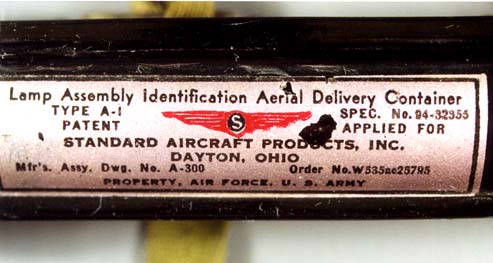
A closeup of the nameplate on the same light. This was activated by 2 C-cell batteries, and the contacts were seperated by a piece of cardboard attached to a cord, which pulled the seperator out as the bundle left the airplane. Overall length is about 10 inches.
Dust Goggles-M43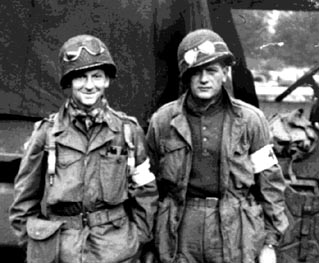
In Normandy, and continuing into Holland, 101st troopers can be seen in vintage film wearing dust goggles on their helmets. Most examples seen in wear by 101st troopers, have clear plastic lenses, but tinted versions for sun protection were also worn. The 101st DivArty medics shown in Holland above, are wearing both types. Ed Hughes of F/501 gave me a set with clear plastic lenses and stated that they were NOT worn on the face during jumping. The main reason they were issued, was that the troopers complained about dust being blown up from the roads when they were riding in the back of 6x6' trucks. A commonly-seen helmet ornament, especially during Market-Garden, few photos show them being actually worn on the face. vintage photo courtesy Nadine
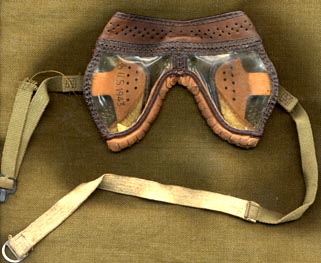
Here's a closeup of what the M43 goggles with clear plastic lenses look like. These fragile items are dated 1943 and are made of thin leather with elastic strap construction. The bottom edge is lined with a narrow fleece strip to pad the nose and cheek. These are ink stamped "AO 1943" (made by American Optical co., like many other types of goggles). Because of their fragile construction, worn examples are seldom seen, although cases full of the tinted ones were discovered less than 20 years ago and were frequently seen for sale at collector shows. Not limited to Airborne troops, the last pair I got belonged to a 94th Infantry Division vet. Below, a detail of the envelope these goggles were issued in.
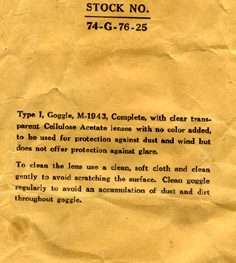 Eyeshield, M-1-The Missing Link
Eyeshield, M-1-The Missing Link
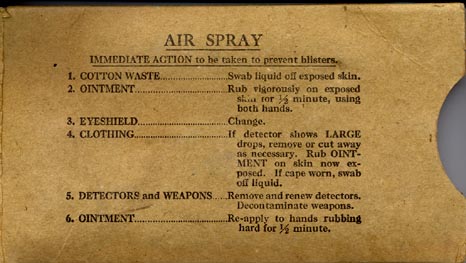
The missing link in gas warfare equipment is the 'Eyeshield, M-1', which came 3 to an envelope, in the cardboard container shown above. Of the 3 pr enclosed. one had clear plastic lenses and the other 2 had tinted lenses. As you can see, the directions on the envelope tell what to do in event of a gas attack. It is probable that these kits were issued in, or with the assault gas mask bag, like the paper gas detection brassard. It is also probable that the few which can be seen in wear by 101st troopers in Normandy, were utilized as sunglasses or perhaps dust goggles, as were the M43 goggles.
One scene in the HBO 'Band of Brothers' series, depicting the liberation of Eindhoven, shows a E/506th character wearing a pr of these gas goggles-a rather obscure item of equipment.
Thanks to Drew Cook for providing the specimen shown, as well as some insights into their issue and use.
ESCAPE & EVASION KIT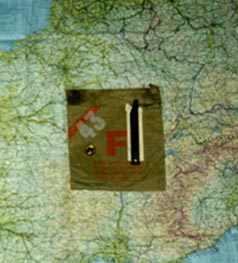
Various versions of the E&E kit existed but this was the type issued to Paratrooper officers for Normandy. I suspect leftovers were issued to EMs until they ran out. The example shown was issued to CWO Charles Carlsen of the 501 Rigger Section. there is a cloth map of France, showing escape routes to Switzerland, a small steel hacksaw blade in cardboard container, a tiny compass, and (missing) French paper currency. The brown kraft paper envelope bears a large red 'F'for France. Small enough to conceal in a human anus, the compass became known as the 'asshole compass'. Below is a black and white photo of the hacksaw blade and asshole compass. These are a bit larger than actual.
It should be noted that several types of cloth maps exist, each showing different geographical areas. I've seen the France type illustrated here, as well as a variant for the Dragoon (Southern France) invasion, used by the 1st Airborne Task Force, and yet another, for Varsity (the Rhine jump), used by the 17th ABD.
These escape kits were originally intended for, and issued to Air force flight personnel and an attempt was made by 101st ABD HQ, to recall any kits which were still intact after Normandy, so they could be re-issued to flight crews.
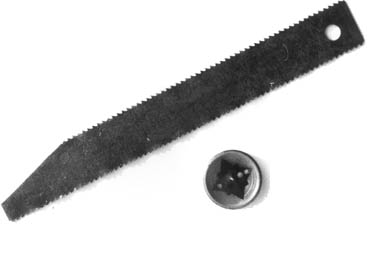 Variant Asshole Compasses
Variant Asshole Compasses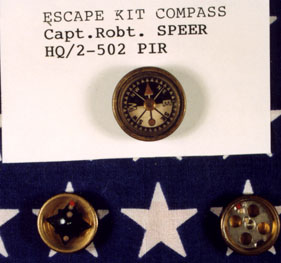
The top variant is attributed to Captain Speer, although he joined the 502 as a post-Normandy replacement. The example lower left, is most commonly found type used in escape kits. The specimen at bottom right, came from Ken Jago, who belonged to a Tank Destroyer Bn.
Sound-Powered Phone
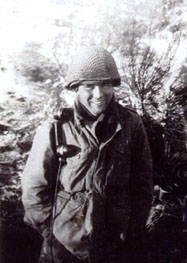
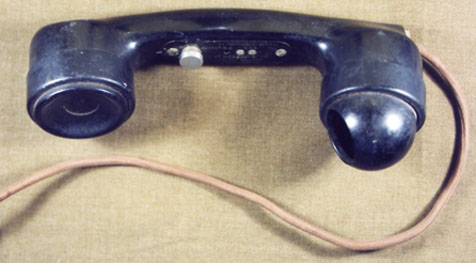
This type phone was used on the OPLR (Outpost Line of Resistance), where being quiet was essential to survival. Instead of cranking a handle to generate electricity and ring a bell at the other end, the user whistled softly to alert the soldier at the other end, who always had the phone close to his ear,(in theory). This set-up operated without electronic amplification and was a forerunner to the fiber optic wires used in the 21st century. Note the plastic cupped section over the mouthpiece, to facilitate the whistle alert system.
The actual phone depicted above was retained by Lt. Don Hettrick, who used it at Bastogne, in connection with his duties as a Forward Observer for the 377th PFAB. One afternoon, when Don whistled into the phone to alert a member of his team to relay a fire mission to the Fire Direction Center(FDC), all he heard on the other end of the line was loud snoring.
In the photo above left, an observer for 501 PIR 81mm mortars near Bizory wears a sound-powered phone under the epaulete of his M43 combat jacket, to keep it close to his ear. The cupped mouthpiece is visible in this photo by Ken Hagenbuch of the 81st Airborne AA/AT Bn.
Compass and Case

Most 101st troopers who carried a compass were issued the black metal Corps of Engineers type compass shown above. This was carried in a creosote-treated green canvass pouch, which attached to the lower front of the pistol belt or cartridge belt. The set depicted above was worn throughout WW2 by radio operator Sgt Gordon Yates of Co. H 506th PIR. Yates was awarded the Silver Star for his work during the battle of Opheusden, Holland in October, 1944.
Compass Type M2
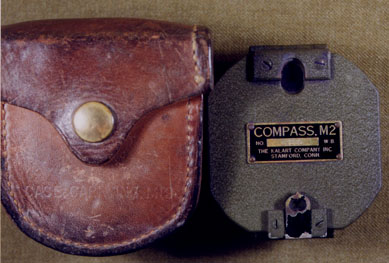
The steel compass shown above was intended for use by artillery observers and is of much heavier construction than the Corps of Engineers compass (which was encased in a thin, non-magnetic metal, electrostatically painted black). This larger compass, along with it's leather carrying case, was salvaged from a fallen U.S. artillery observer (from a VIIth Corps artillery unit in Normandy), by Lt. John Reeder of HQ/506th. Lt. Reeder wore the pouch on the lower front of his suspenders as is depicted on numerous Normandy photos made by his camera.
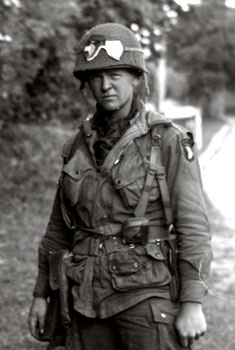
This photo shows Lt. John Reeder of RHQ/506th PIR in Normandy. Note the leather compass pouch worn sideways on his lower left suspenders. This is the same pouch and compass depicted above. Lt. Reeder also wears a standard Corps of Engineers compass, in a canvass pouch, directly below the M2 pouch, under his pistol belt.
GI Wrist Watches
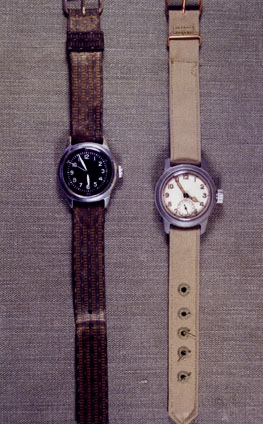
The watch shown at left was made by Waltham and the strap is filthy, indicating it was well-worn in the field. Other makers have been noted on these standard WW2 GI watches. This one is shown courtesy of Eugene 'Red' Flanagan of SV/501.
The more expensive Engineer style watch at right was less common and appears courtesy of Lt. John Reeder, HQ/506th PIR.
Due to a perpetual shortage of these watches, they were limted in issue, to noncoms and officers. A system of accountability required most of them to be turned-in at the end of WW2 and few vets managed to 'liberate' one for postwar use.
RIGGER MADE MAP POUCH

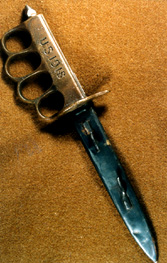

When not busy packing or repairing parachutes, the Riggers were quite handy at improvising pouches and cases for weapons, ammo, grenades, medical supplies, maps etc. The pouch depicted above was Rigger-made and used from Holland to Austria by Sgt Tom Enright, 1st platoon F/501 PIR. This pouch secures to web belts or suspender loops by a metal hook at the top and by tie laces at the bottom. It contains a leather-edged, acetate insert. Sgt Enright added his initial and partial serial number with an ink stamp device.
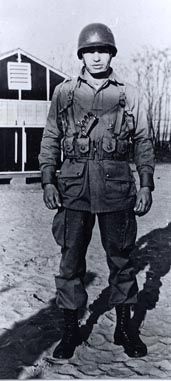
A number of WWI era brass knuckled trench knives were kept in storage by the US Army and re-issued during WW2. The example shown is marked "Au Lion" on the blade, and was made in 1918 by a French company on a US government contract. It was issued to Joe Pistone of F/502. The photo below shows Frank Anness, the supply sgt of D/506th at the Port of Embarkation in mid 1943. In his belt is one of the WW1 knuckle knives, which Frank says were issued to D/506th just before boarding the SS Samaria. But Frank says the knives were confiscated within a day or two, because too many of the high spirited paratroopers were trying them out by 'dueling' with each other, resulting in an alarming number of injuries.

